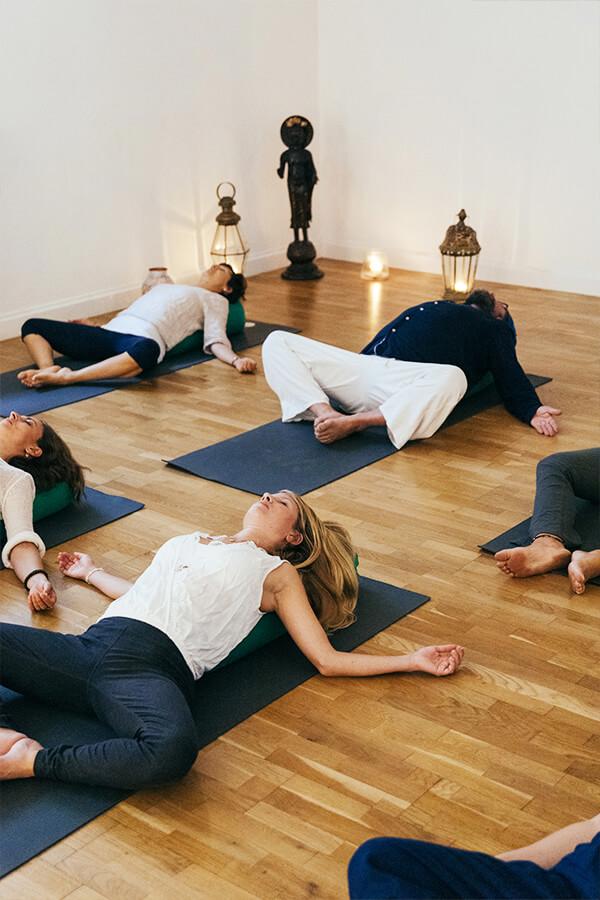
WHAT IS YIN YOGA?
AND HOW DOES YIN YOGA WORK?
Yin yoga stands apart from other yoga practices with its unique approach to physical and mental wellness. This gentle yet powerful practice emphasizes holding poses for extended periods while working with the body’s deeper connective tissues. Unlike dynamic yoga styles that focus on movement and muscle engagement, yin yoga encourages stillness and surrender.
At the heart of Yin Yoga lies a profound understanding of how our bodies respond to gentle, sustained pressure. This meditative practice is built on four fundamental principles that guide practitioners toward a deeper connection with their bodies and minds.
Definition and core concepts
Yin yoga is characterized by passive poses held for extended periods, typically ranging from 3 to 10 minutes. Unlike dynamic yoga styles, it emphasizes minimal muscle engagement and focuses on creating gentle stress in the body’s deeper tissues. The practice is guided by four essential principles:
- Finding your edge: Enter poses with appropriate sensation, avoiding sharp or aggressive feelings
- Muscle relaxation: Allow the targeted area to soften
- Stillness: Maintain relative stillness during holds
- Mindful transitions: Move slowly in and out of poses
Yin vs. Yang yoga styles
The concept of yin and yang in yoga reflects the natural balance of opposing forces. Here’s how these contrasting elements manifest in different yoga styles:
- Yin qualities: Slow, passive, cooling, longer holds, floor-based poses
- Yang qualities: Dynamic, active, heating, shorter holds, standing poses
It’s important to understand that nothing is inherently yin or yang – these qualities exist in relationship to each other. A Hatha class might seem yang-like compared to a yin class but yin-like compared to a vigorous vinyasa flow.
Focus on connective tissues and joints
Yin yoga specifically targets the body’s connective tissues – the fascia, tendons, ligaments, and joint capsules. These “yin tissues” respond differently to stress than muscles do. While muscles are elastic and quick to respond, connective tissues are more plastic-like, requiring longer, gentler pressure to achieve lasting change.
When practicing yin yoga, we work with three primary types of stress:
- Tension
- Compression
- Contraction
This focused approach helps improve flexibility and joint mobility in a sustainable way. Props like blocks, bolsters, and blankets are commonly used to support the body during long holds, allowing practitioners to find their optimal edge while maintaining comfort and safety.
The practice acknowledges that everyone’s skeletal structure is unique, meaning that poses will look and feel different for each person. This understanding promotes a more individualized approach, where practitioners are encouraged to explore and adapt poses to suit their bodies rather than forcing themselves into predetermined shapes.
The Origins and Philosophy of Yin Yoga
The ancient wisdom of Chinese Taoism forms the philosophical foundation of yin yoga, blending centuries-old practices with modern understanding of the body and mind. This unique practice emerged from a rich tapestry of Eastern traditions, evolving into the form we know today.
Taoist roots and Chinese medicine influence
Rooted in Taoist philosophy dating back 2,500 years, yin yoga embraces the concept of living in harmony with nature’s rhythms. The practice draws heavily from Traditional Chinese Medicine (TCM), incorporating the understanding of chi (life force energy) and meridian pathways throughout the body. These meridians, similar to what Indian traditions call nadis, flow through the body’s connective tissues—precisely where yin yoga focuses its attention.
The practice emphasizes working with the body’s natural elements and energies:
- Earth – representing stillness and grounding
- Metal – embodying strength and structure
- Water – symbolizing fluidity and adaptation
- Wood – expressing flexibility and growth
- Fire – manifesting transformation and warmth
